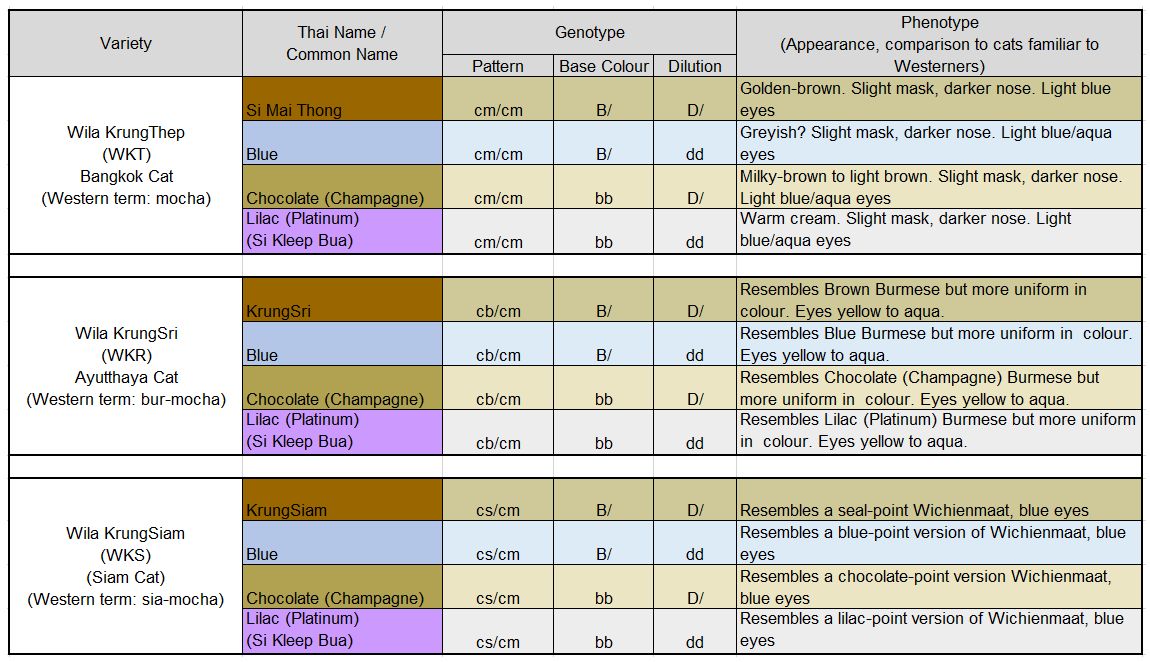
MOCHA GENETICS- INTERACTION WITH SIAMESE AND BURMESE COLOUR RESTRICTION
Doug Schar has provided information on the Mocha gene and photos of how it affects different basic colours and interacts with the Siamese and Burmese patterns. His website is Bangkok Mocha Cats Doug is collecting photos of the cats at various ages. Hopefully that will give interested parties something to start with. More photos will be added to this page as cats are born and grow up and their colour develops.
"I have been working on the cm [mocha] project and now have cmcs cats in sable [brown], blue, chocolate [champ[agne], and platinum [lilac]. I have cmcb cats in all four colors. And I will soon have cmcm in all four colors. If I had to summarize my experience thus far, it is easy to see how the gene went undetected for so long. In many of the color options, it would go undetected. As an example, a BB cmcb dd is indistinguishable from a BB cbcb dd. And a BB cmcs DD looks like an off-colored Siamese. BUT... it always makes the eye color pop, cmcm or cmcs or cmcb."
"A big part of my work is rescuing the Thai descent cats from decimation in the west. This is why I have gone to Thailand to study exactly how these mutations mate, move, and remain healthy there. I have several thoughts on the matter.
Obviously inbreeding occurs outside of Thailand. And that is never good. But the other thing that happens is color breeding. It is my theory that color breeding is also a bad idea and may contribute to the decline in the cats outside of Thailand. My most notable example of this would be with the five Korats imported to the US to start the Korat breed in the US. Being Thai cats, they came carrying cb, cs, and chocolate. Whenever a cat gave birth to a cat that was not Korat Blue(Siamese, Burmese, chocolate, or lilac) the Koran breeders excluded those cats from the gene pool. After a while, they had successfully bred out all the genes that would be normally present in a Korat in Thailand. (One American Korat breeder told me "Blue and Only Blue" was their motto.) Once they had purified them like white flour, voila, the American Korats had kitty ALS Amyotrophic lateral sclerosis []. I wonder about the same practice with all the cats of Thai descent. It is my opinion that when people select for ONE physical attribute, they are also selecting for physical attributes that one cannot see. Like PRA [Progressive retinal atrophy].
I say this because though I have been teasing out all the Bangkok Mocha varieties(cm), and now have many of the possibilities in my possession, I am concerned about the new mutation being subject to a color breeding program like occurred with the Korats. I have not detected any physical abnormalities in the cmcm cats so far, but I have my eyes wide open for something. cmcm cats in Thailand are a rarity, and a (bb cmcm dd) cat would be an even greater unlikelihood. In other words, I may be making the first blue Bangkok Mochas that have ever existed. The chance of one occurring in Thailand is slim to nil.
I used to breed parrots. The conventional wisdom in those days was never breed a mutation bird to mutation bird. . . . if you wanted to produce a blue bird, you do it by breeding two green birds that carried blue. Never mate blue to blue. You would end up with defective chicks. And I saw that with my own eyes. I know that would be a huge leap, parrots to cats, but, I wonder if it applies to them as well. Ergo I am proceeding with caution with the cmcm cats. Again, this is all theoretical, but, ultimately it may be better to produce cmcm cats through cbcm x cmcs or Ccm x cbcm matings."
"I am thinking about launching a Natural Cat Breed Association. Not a show organization, just a registry for people who want to breed the Natural Breeds, well, naturally. In CFA, you cannot use an imported Thai Siamese in your breeding program. . . . Having imported, tested, and worked with over 60 cats from Thailand over 15 years, I have learned something about breeding a natural breed of cats. And what I can say for sure is this. These breeds, outside their home domain, are not bred the way they would breed in their native lands. That leads to closed gene pools and sick cats. But breeders have no choice but to register their cats with registries that will not allow them to import new genes from the place of origin. It seems so strange to me. But that is the way it is, and I do not see it changing anytime soon."
Because there was secrecy and competitiveness between labs to be first to identify the gene and develop a test for it, Doug prefers the term "Bangkok-Mocha" rather than Mocha. The first three cats were found on a dock in Bangkok and he insists that their origin should be correctly reflected in the name of the gene. For that reason, I will use his naming convention of "Bangkok-Mocha."
Firstly, a few gene symbols need to be defined. Some colours have different names in different registries so I will use both names for clarity.
|
BB – black/seal/sable (homozygous) Bb – black carrying chocolate (heterozygous) bb – chocolate/champagne DD – dense colour (homozygous) Dd – dense colour carrying dilution (heterozygous) dd – diluted colour (e.g. black to blue, red to cream) In Burmese cats, genetic black is called "Sable" in the USA, "Brown" in UK & Europe. Likewise chocolate & champagne, and lilac & platinum refer to the same colours. |
C/ means the cat is full colour cb/cb, cb/ca - Burmese colour restriction. cb/cm – Burmese-Mocha cb/cs - Tonkinese Colour restriction cm/cm - Mocha Colour restriction cs/cm – Siamese-Mocha cs/cs, cs/ca, cs/c - Siamese Colour restriction ca/ca - Blue-eyed Albino c/c - Pink-eyed Albino |
Mocha is on the same locus as cs and cb. It is incompletely co-dominant to each of those. The diagram below shows the co-dominance but the actual intermediate mocha colours are variable. In the cmcm cats, the pink nose and pink paw pads are strictly a kitten thing. As they age, the nose darkens with age and turns brown, and the paw pads turn brownish. The oddly brown nose is a characteristic feature of the adult cats because, no matter what tone of mocha they are (ranging from reddish to blondish) they always have a brown nose.

Doug has provided commentary on the different classes. It quickly becomes clear how and why the Bangkok-Mocha gene went undetected for so long. Apart from the sable/brown version (BB cmcm DD) the gene only slightly modifies the colour. In some cases the modification is imperceptible, even when you know that cat has Bangkok-Mocha. Across the spectrum, Bankgok-Mocha, Siamese/Bangkok-Mocha, and Burmese/Bangkok-Mocha the one consistency is the luminescent eyes. The gene causes what the Thais call diamond eye - they sparkle and appear backlit. Others have described the eyes as looking like liquid mercury. Unfortunately, this doesn't come out in all photos, but it is present in all the cats.
The Sable (Brown) form of Bangkok-Mocha/Burmese is highly variable. There is great diversity in eye colour and they could easily pass as a light sable (Brown) Burmese. Doug writes "When I read the early books on the breed, in the Harrison Weir time frame, it seems initially the Burmese standard was for blue eyes and then it was changed to yellow eyes. I have a feeling the cm gene was floating around in the early imports."
The only photos missing at present are BB cmcm dd.
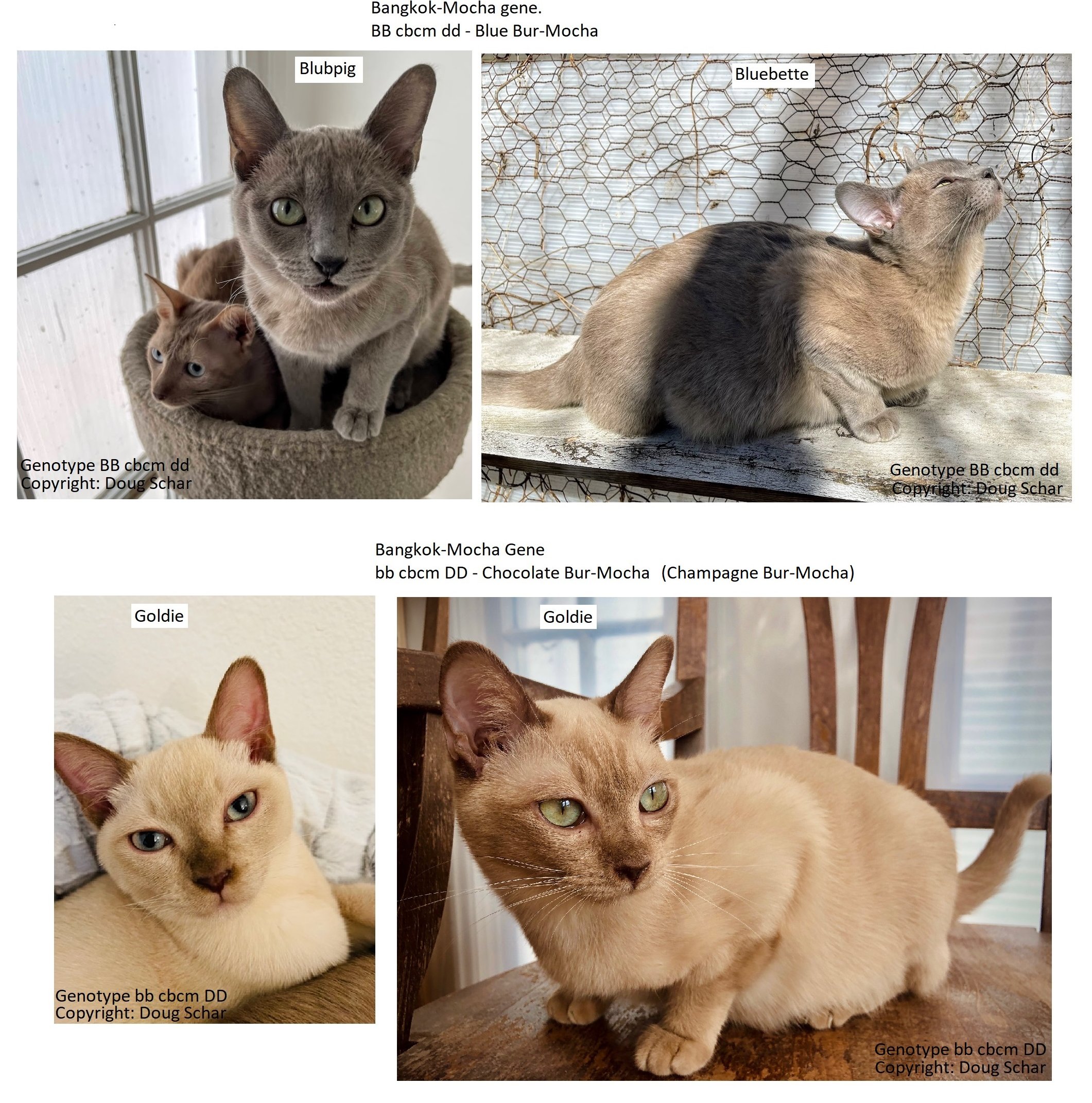
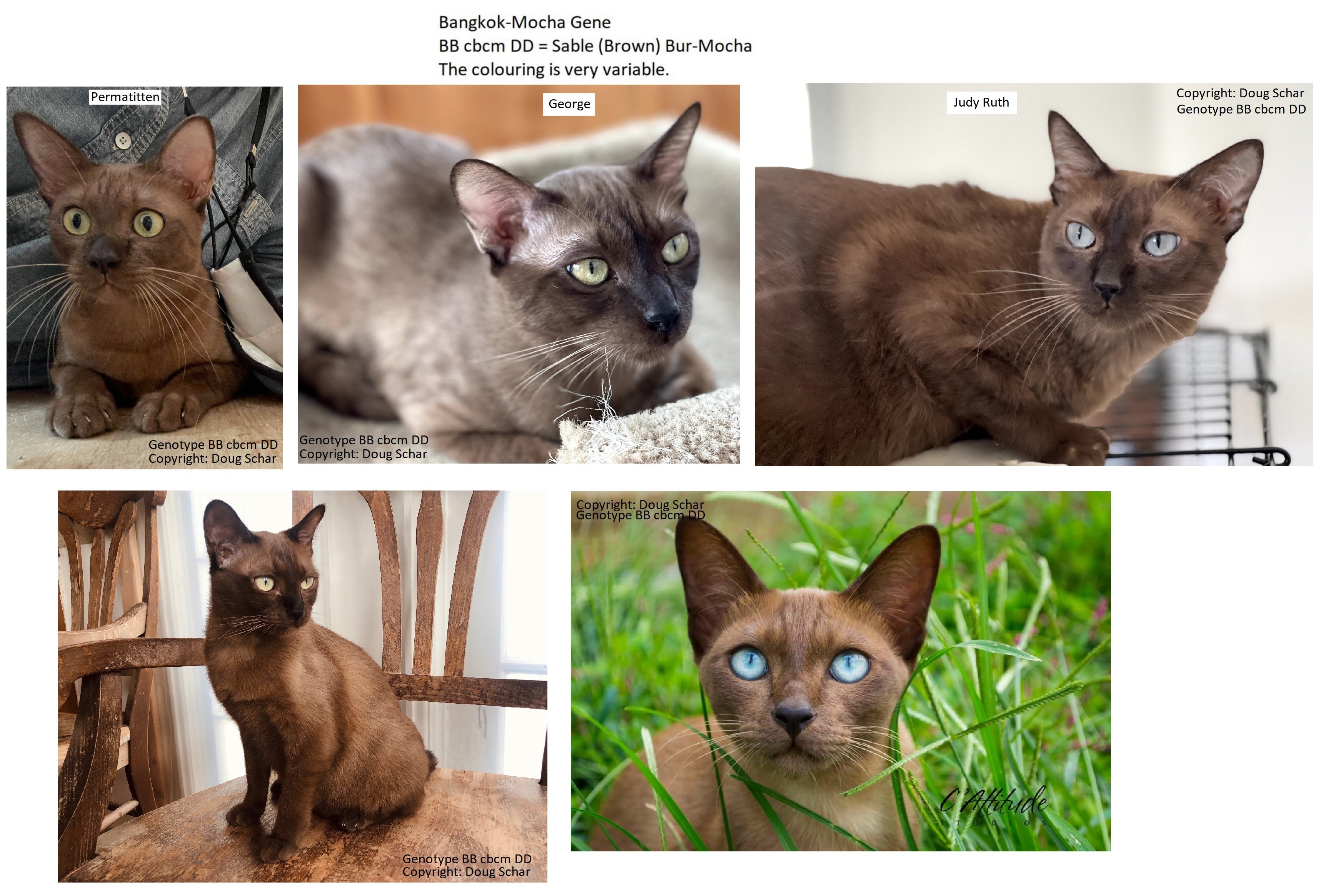
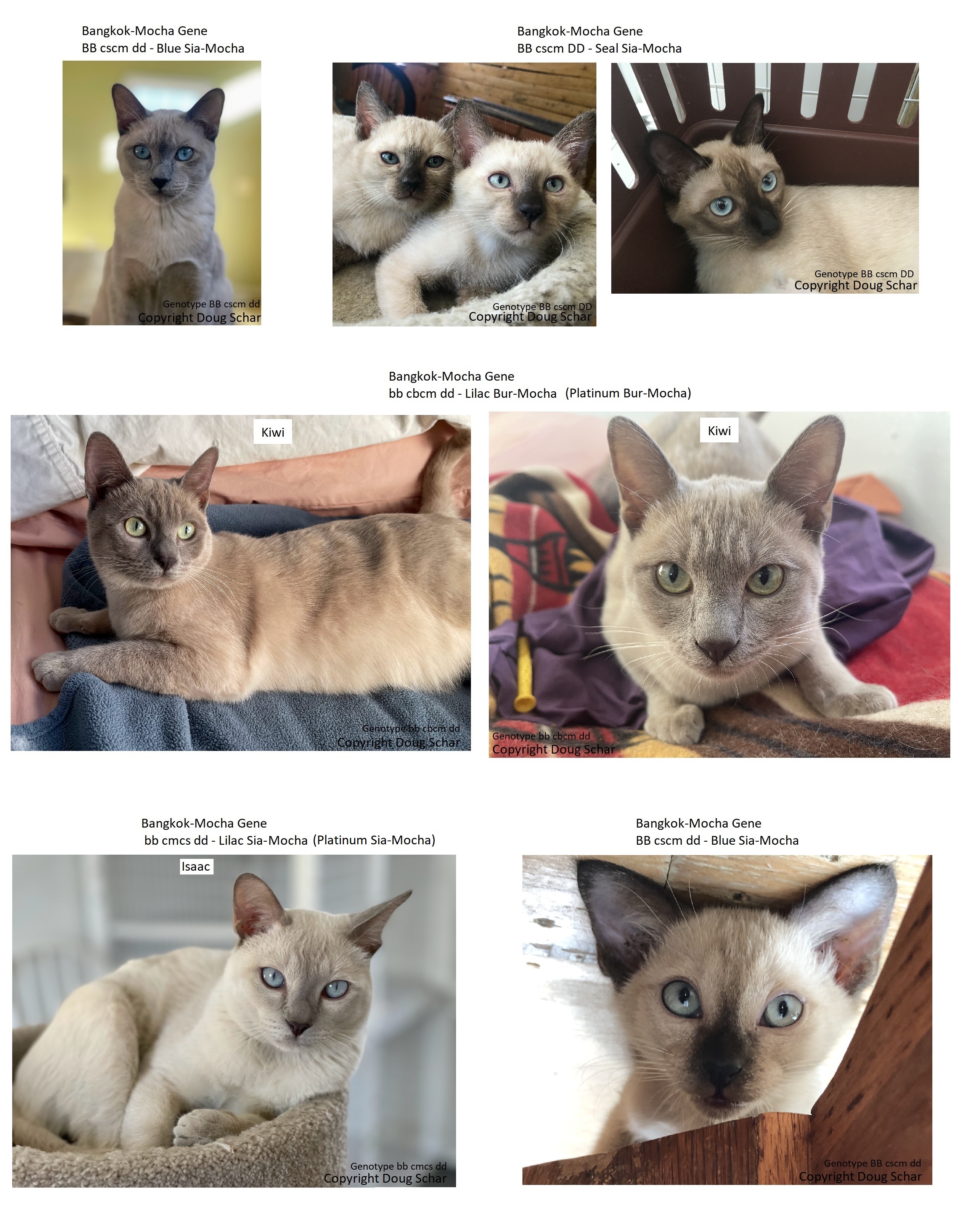
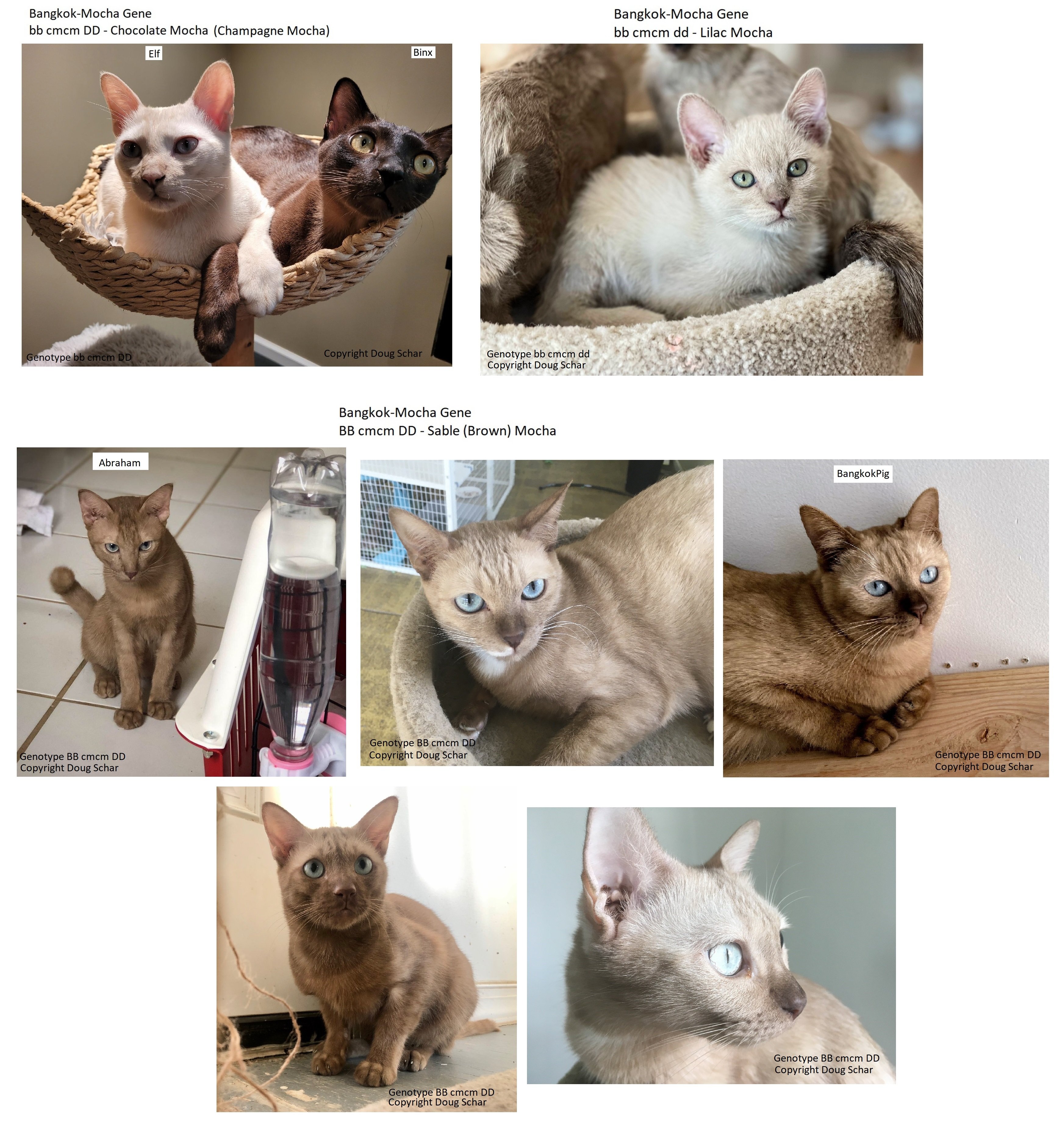
Nolan Betterly stopped breeding mocha cats and sent all the foundation breeding cats, from unrelated cmcm cats, to Doug Schar to continue breeding. Thai people and Thai breeders wanted to name their own cats this time, not accept Western cat fancy names. TIMBA (The International Maew Boran) has a registration system set-up to keep track of everything, though this is not universally accepted by Thais. The Thai preferred term for mocha cats is Wila KrungSri (Ayutthaya Cat). "Wila" comes from an older version of the Thai language and means "cat." KrungSri, or Ayutthaya, was the former capital of Thailand. There is no poem in the Tamra Maew that describes this colour. The closest is the Suphalak, or Thong Daeng, but that should be uniform brown without the pattern seen on "mocha" cats.
Likewise, Wila KrungThep translates to Bangkok Cat. The first Wila KrungThep identified in Thailand was named Mai Thong ("golden silk") because of her unusual light golden looking coat. The colour of the Wila KrungThep is therefore called Si Mai Thong or "the color of golden silk." It is not described in the Tamra Maew.
